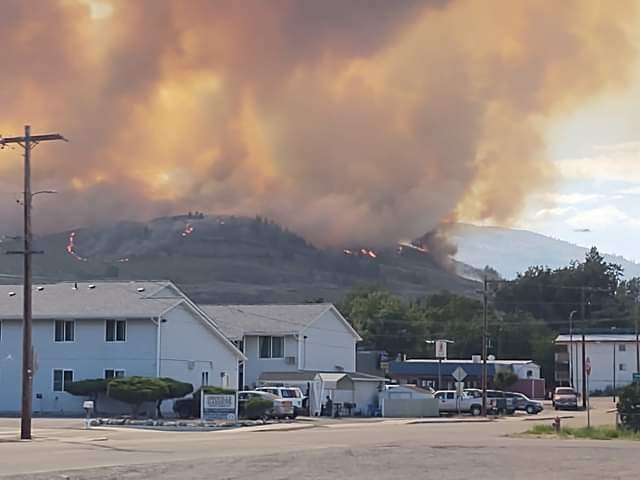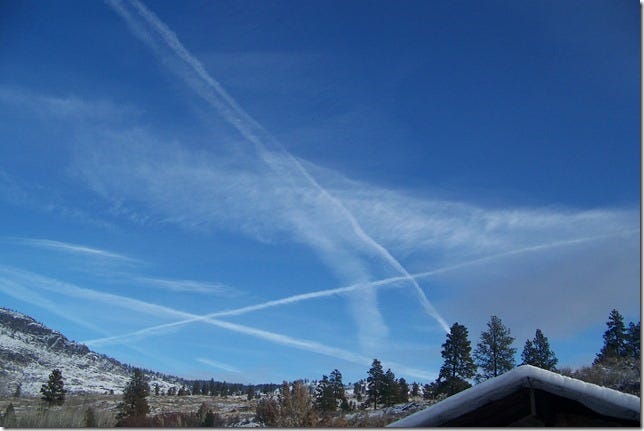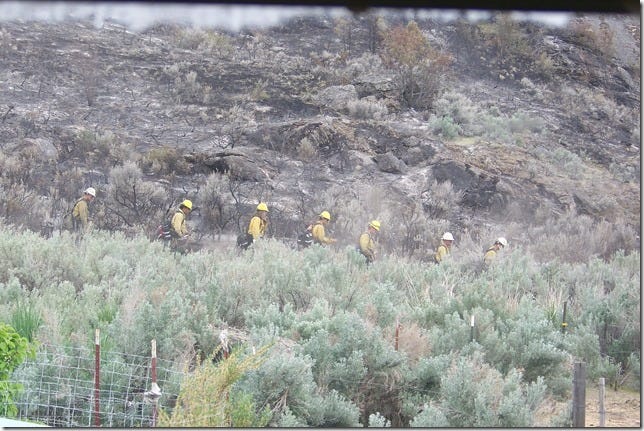The Eagle Bluff fire started Jul. 29 at 2:03PM. Human caused, like 85% of wild fires, is about 10 miles away from our property. A hot fire generates so much heat it creates Pyrocumulonimbus clouds, which rise eight to ten miles in the air, creating their own weather system.
Between the seasons of spring and fall, the Western U.S. has a fifth season. Fire season. There have been small fires. Maybe a few acres. The Eagle Bluff fire, named for the area it started, quickly raced seven miles north to the town of Oroville. Then into Osoyoos, British Columbia, another five miles, growing to 2,500 acres. Overnight it grew to 10,000 acres. Today 16,428 acres. 564 personnel assigned not counting the dozens of aircraft and 45% contained. In Osoyoos, it grew to over 4,000 acres and was mostly out of control.
Air fire suppression across from our property
Fighting wildfires on the ground is, of course, extremely dangerous work. Fighting them in the air may be more so. You're flying through air currents constantly experiencing drastic temperature changes which change the lift available on your wings or rotors. Did anyone ever experience air turbulence in a commercial jet? A day at the office for these people. Note. These pictures are not out of focus. They are being taken through heavy smoke.
A McDonnell Douglas MD-87 jet dropping fire retardant. They carry 4,000 gallons of retardant.
Helicopters too far to identify with water buckets.
A McConnell Douglas DC-10 making a retardant drop in smoke. It carries up to 12,000 gallons of retardant or water.
DC-10 leaving empty.
Air fire supression near Oroville
Photo by Howard Floyd Closer view of a McDonnell Douglas MD-87 jet like the one across from my property.
Photo by Ryan Frazier Fire Boss Air Tractor AT-802Fs over Oroville. They drop down onto a body of water and open slots in the pontoons to suck the water. Capacity per plane is 800 gallons.
Air suppression near Osoyoos
A Convair CV-580 dropping fire retardant near Osoyoos. It carries 2113 gallons.
Images of Oroville when the fire arrived
Photo by Angela Reed
The fire on the hill right behind the local shopping center.
The Eagle Bluff fire reaching Osoyoos
Photo Canadian Press
As of August 1, 2023, at least five homes have been lost. Evacuations are still going on as the fire spreads.
Eagle Bluff Fire Day 6
It ain't over till it's over. - Yogi Berra
Blow up in Canada.
We always get the best sunsets in fire season.
Fire progress as of Aug. 3. We were observing the start of the fire from the vicinity of Mt.Hull. Unfortunately, it is still very active in Canada.
Recent fires are not the biggest ever
From World Atlas: Largest Brush and Forest Fires in Recorded History
2014 Northwest Territories Fires, Canada 8,400,000 acres
3. The 1989 Manitoba Fires, Canada 8,105,000 acres
1939 Black Friday Bushfire, Australia 5,000,000 acres
The Great Fire of 1919, Canada 5,000,000 acres
1950 Chinchaga Fire, Canada 4,000,000 acres
2010 Bolivia Forest Fires, Bolivia 3,700,000 acres
1910 Great Fire United States 3,000,000 acres
1939 Black Friday Bush Fires, Australia 2,000,000 acres
2011 Richardson Backcountry Fire, Canada 1,700,000 acres
# 1. The largest modern day wildfire
Photo strangesounds.org
2003 Siberian Taiga Fires (Russia) – 55 million acres or 85,937.5 square miles. The state of Maine is 86,935.83 square miles and the state of Utah is 84,896.88 square miles.
Why wildfires so frequently occur in the Western United States (and Canada), and NO, its not “climate change”!
Photo CONIFEROUS FOREST: Ponderosa Pine, one of the most abundant in the forests.
The vast forests across the Western United States and Canada for the most part contain conifers, meaning they have needles instead of leaves with their seeds in cones. Ponderosa Pine, Douglas Fir and Tamarack trees are common in my area. Redwood and Cedars are present in California. Very flammable once a fire gets hot enough to ignite them, as in my initial picture. (Turpentine does come from pine trees.) A fire will actually run for miles through the tops of the trees and never touch the ground in some instances. Or whole 60ft. trees will spontaneously burst into flame like a big match! Incredible and terrifying to see. Also, grasses that dry in the summer and sage brush, which are as flammable as gasoline and burn longer because they contain an oil.
Historically poor forest management. (Blame Smokey the Bear.)
Fire is a tool of nature that thins the forests. Conifers were ingeniously created to survive fires that burn through and clean out undergrowth. When trees become too numerous and/or diseased, fires historically were started by lightening and still are. Today, by stupid people or actual arsonists. These fire will burn through and remove everything, leaving nothing but ash and sterile ground that nothing will grow on for years! With the addition of highly volatile aluminum and barium dust from chemtrails, these fires are practically unstoppable. Creating bare hillsides to be washed away as in the dangerous mudslides so common in California.
By putting out every fire and not thinning or using controlled burning for decades, hundreds of millions of acres are ripe for disaster.
In the Colville National Forest, trees as big around as semi truck tires grow feet away from each other. With burnable debris up to your knees on the forest floor.
Across the West, leasing agreements with ranchers are being cancelled to graze federal lands, leaving grasslands growing waist high waiting to catch on fire. So the whole habitat of the Sage Grouse or whatever, burns up because you were worried a cow might step on one? Which in actuality would never happen.
Wasting scarce funds fighting enviromentalists suing to keep Forest Service and state agencies from contracting the removal of useable lumber for sale and cleaning up undergrowth. Without thinning, nature will intervene.
2014 Carlton Complex fire left burnt standing trees. Forest Service and Washington Department National Resources were sued to prevent them from contracting the harvesting of useable lumber for sale while cleaning up the woods.
The White Mountain fire of 1988 burned 21,000 acres including the area near Sherman Pass. It was never cleaned up or harvested! Today you can drive by and see 20,000 acres of rotting, diseased trees just waiting to be lit like a match!
Regarding stupid people. The Eagle Bluff fire is human caused. Allegedly by someone grinding metal near combustible material without water or a fire extinguisher. Local fires within three miles of our property over the last few years were started by knuckleheads shooting exploding targets too close to their car and blowing it up. And meth heads abandoning their roving car meth lab that caught fire in a hay field causing a 750 acre fire endangering several homes.
A Canadian Convair CV-580 making a loop for another drop on the meth head fire about two miles away.
Regarding arson:
A criminology professor was charged with wildfire arson in California. The crime is far more common than you think. Between 2010 and 2019, arson was linked to more than 2,000 wildfires, the Cal Fire report said.
Chemtrails are causing increasingly dangerous fires
An aspect of the absurd geoengineering concept, that by seeding the skies with a mixture of mostly aluminum and barium powder in addition to numerous other substances, we can lower imagined “human caused global warming” aka, “climate change.” GeoEngineering Watch is an authorative site on the subject.
If you think it's a “conspiracy theory”, this is a link to a Harvard study on the subject. The white plumes you see all over the sky are not jet exhaust! Actual exhaust, or contrails, dissipate a few feet after the engine almost immediately.
Photo by Linda Picture of normal sky.
Photo by Linda Picture of a chemtrail sky. Notice how the plumes disperse and blanket the whole sky.
Millions of tons of aluminum and barium are being sprayed almost daily across the U.S., stated Mills, a former naval officer and UCLA graduate. "Just sprinkle aluminum or barium dust on a fire and see what happens. It's near explosive. When wildfires break out, the aluminum/barium dust results in levels of fire intensity so great as to cause firefighters to coin a new term ̶ 'firenados,' " he said. The entire U.S., in addition to various other NATO countries, are being sprayed.
“Firenados”
Incredible examples of when a fire actually creates a tornado of fire. One even grabs a fire hose and sucks it in. A must watch.
According to Cal Fire operation chief Steve Crawford, the fires are burning differently and more aggressively. It has been reported the fires move faster than anyone has ever seen and barriers that in years past contained them such as rivers, no longer do.
In California's Mt. Shasta region, Francis Mangel, a USDA biologist tested and found elevated levels of aluminum in water and soil samples of 4,610 parts per million which is 25,000 times the safe guidelines of the World Health Organization.
Fires are burning much hotter and as in the Carlton Complex Fires, which burned everything, then wind sent them back to burn the areas again! There was nothing left to burn! What was burning so fiercely? A friend lost his home that way. The fire went through, changed direction and came back to burn the old house he beautifully restored.
It is far worse in Canada
In addition to all of the above:
Canada has an infinitesimal forest budget compared to the United States with much more forest to manage.
The enviromentalists are much more fanatical.
Largest fires in Washington state history
2020 - Cold Springs Canyon/Pearl Hill Fires
Okanogan/Douglas counties
Over 410,000 acres or 640.625 square miles. The city of Houston is 640.4 square miles.
One death. An infant.
2015 - Okanogan Complex Fire
Three fires that came together. North Star - 218,138 acres Tunk Block - 165,918 acres Lime Belt - 133,450 acres
Okanogan and Ferry Counties
304,782 acres total or 476 square miles. The entire city of Los Angeles is only 469.5 square miles.
Three deaths and 195 structures lost
2014 - Carlton Complex
Okanogan County
256,108 acres or 400 square miles. The entire city of New York is only 305 square miles.
One death and 300 structures destroyed. Obama’s FEMA refused aid, despite destruction including structures on the Colville Reservation!
Fires VERY close to home
What my wife and I call the “Mother’s Day Fire”, May 12, 2019.
I was making an Eggs Benedict breakfast when I heard our horse, Amara, frantically running and snorting. 40 yards to the South of our property the sagebrush was engulfed in flames with billowing smoke above it! Apparently, the person living next door decided it was a good idea, without a hose, to burn her weeds in the middle of the sagebrush! (Years before, she left us speechless when she said sagebrush doesn't burn.)
Now that will get your attention! Amara is in the lower right corner.
A saving grace was a strong North to South wind which was keeping the fire back. Still, the fire did grow from an acre to 20 in less than an hour. Amazingly and to their credit, a Washington Dept. Natural Resources Wildland Fire Crew was here within 10 minutes. The Fire Boss politely asked if they could set up and stage from our property. (No? 🤔)
Photo by Linda One of these is not like the others. Two more helicopters preceded this one, asking politely if they could land in our yard. (No? 🤔)
The local Mt. Hull volunteer fire company was attacking the fire from the East at our neighbor’s property. Within another 10 minutes City of Oroville water tenders arrived to back up the crew. A water tender came from the Aeneas Valley volunteer fire company 40 miles away. Regarding wild land fires, all the fire companies back each other up. The DNR Incident Commander was so concerned about how fast it was spreading he requested small or large fixed air tankers, but none were immediately available. Three helicopters were available along with D4 or D5 dozers to cut fire lines around the perimeter. There was also a Forest Service crew deployed to the North and East to stop the fire before it got to heavy timber.
Photo by Linda Me introducing Amara to the helicopter crew and the “scary helicopter”, with the third coming in with a water bucket to drop on the fire. Amara was an original Arabian. One of the oldest breeds, it dates back almost 4,500 years. They are known for their intelligence, stamina and speed, and are used to improve other breeds by adding speed, refinement, endurance, and strong bones. Consequently, Arab blood is in almost every modern horse breed. Sadly, we lost her last year at age 26. She was a very good and smart girl.
The helicopters are a Bell Huey UH-1H or Super Huey. One of the most produced military helicopters in history. A large number of these helicopters became available as surplus. Very reliable with a large payload capacity made them perfect for firefighting use. This size helicopter has a 324 gallon bucket beneath it dipped into any nearby body of water then onto the fire. Their rotors are VERY loud! Not so much on the ground, but when they get 50 to 100 ft. in the air it is deafening, with your whole body and everything else vibrating! The sound is actually pounding on you. Our one chicken didn't lay eggs for years.
Photo OKANOGAN VALLEY GAZETTE TRIBUNE Fighting the fire to the North and East to keep it from crossing the road into heavy timber.
Photo by Linda the fire crew hard at work making sure the fire is completely out. A dangerous and physical job. You must be able must complete a three-mile hike with 45-lb pack in 45 minutes or less. In addition, being able to carry rolls of hose stretched all over the hill. An interesting link detailing the physical demands, weight training and cardiovascular training required to be a Wildland Firefighter.
Photo by Linda Did anyone ever see any of the “Minion” movies?
The fire ended up at 50 acres with no people, animals or structures lost. The crew took very good care of us working all night and a few days after making sure every square inch of ground was no longer hot enough to ignite. This is done with infrared equipment and actually feeling every inch of ground for heat.
Photo by Linda They even work in the rain.
The Incident Command would report to us every step of what they were doing. When he told my wife Linda they were “in the mop up stage”, with a straight face she answered, “but I don't see anyone with mops.” He got the most perplexed look and answered, “you mean like with a handle?” She couldn't hold it anymore and busted out laughing that she was just messing with him.
July 3, 2019, the Swanson Mill fire, 600 yards to the West of our property
Accidentally started by a hay farmer on the other side of the mountain to our West when a bearing on his hay cutter got hot and lit up the field.
Photo OKANOGAN VALLEY GAZETTE TRIBUNE A Canadian Convair CV-580 air tanker dropping retardant to the North of the Swanson Mill fire.
Photos Courtesy Okanogan Emergency Management
Photos Courtesy DNR
The fire from our viewpoint.
Amara indifferent to the flames only 600 yards away.
The fire ended up at 281 acres with 155 personnel assigned, including three hand crews, 12 engines and one dozer, in addition to air support. No life, animals or structures were lost.
The bright side of the story
We were fireproofed to the South, East and West. We still have the North to be cautious of. A better situation than hurricanes or tornadoes? It's all relative. However, we all owe enormous gratitude to emergency personnel no matter where we live. They daily risk their lives to save ours.
Let them know you appreciate it!



































Idiot do good politicians and environmentalists are a major cause of worsening a lot of these major fires. Stay safe out there!
FINALLY have rain, if it doesn't turn into a twister, we are still cleaning up after the last ones. Yes multiple. And it's July-Aug. that are our southern hottest, lack of rain months that damage buildings and crops. But I've seen Dec with 80+ temps and the AC on. 1 inch of snow paralyzes the Memphis area. We don't have the snow equipment the NE has. As snow is seldom, it;s more Ice storms.